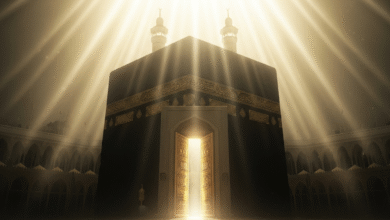Prophetic migration: From Mecca to Medina Historic transformation and nation-building

The Prophet’ s migration was not just a move from one place to another, but a major turning point in the history of Islam and humanity as a whole. From Mecca, which narrowed down the Muslims, to Medina, which welcomed them with open arms, the process of building the first Islamic state began. It was not just an escape from harm, but the establishment of a strong nation and state. What were the reasons for this blessed migration, and what were its main achievements?
Reasons and motives for migration: Hurt and promises of victory
After years of secret and open proselytizing in Mecca, the Quraysh’s abuse of the Prophet and the Muslims intensified. This harm reached its peak after the death of his uncle Abu Talib and his wife Khadija, who had been his support and help. There was no longer anyone to protect the Prophet in Mecca, and his life and the lives of his companions were in constant danger.
At this difficult time, relief came from outside Mecca. The Prophet (peace be upon him) met delegations from the people of Yathrib (later Medina) during the pilgrimage seasons. They believed in him and his call, and made the first and second pledge of allegiance to Aqaba. In the second pledge of allegiance, which took place in the thirteenth year of the Prophethood, seventy men and two women from the Ansar (the people of Yathrib) pledged allegiance to Islam, and to support and protect him as they would protect themselves and their families. This pledge of allegiance was a decisive turning point, giving Muslims a safe haven and a base from which to launch.
Careful planning and the secrecy of the journey: Wisdom and Tawakkul
The migration was not random; it was a divinely-planned and well-planned migration by the Prophet (peace be upon him). He ordered his companions to gradually emigrate to Yathrib, while he and Abu Bakr al-Siddiq remained waiting for divine permission. When the order came, the Prophet took every precaution:
- He left his house at night with Abu Bakr al-Siddiq.
- He headed south against the direction of the city to mislead the polytheists.
- He stayed in the cave of Thawr for three nights, while the Quraysh infidels searched for them everywhere.
- He hired Abdullah ibn Ariqat al-Lithi as a guide who knew the roads, and was still a polytheist, a sign of trust and wisdom.
- Abdullah ibn Abu Bakr would bring news to them, and Amer ibn Fahira would graze the sheep around the cave to obliterate their footprints.
Evidence: These precise details are documented in the authentic biography books, and the Holy Qur’an refers to this difficult moment in Almighty God’s words:1
إِلَّا تَنصُرُوهُ فَقَدْ نَصَرَهُ اللَّهُ إِذْ أَخْرَجَهُ الَّذِينَ كَفَرُوا ثَانِيَ اثْنَيْنِ إِذْ هُمَا فِي الْغَارِ إِذْ يَقُولُ لِصَاحِبِهِ لَا تَحْزَنْ إِنَّ اللَّهَ مَعَنَا ۖ فَأَنزَلَ اللَّهُ سَكِينَتَهُ عَلَيْهِ وَأَيَّدَهُ بِجُنُودٍ لَّمْ تَرَوْهَا وَجَعَلَ كَلِمَةَ الَّذِينَ كَفَرُوا السُّفْلَىٰ ۗ وَكَلِمَةُ اللَّهِ هِيَ الْعُلْيَا ۗ وَاللَّهُ عَزِيزٌ حَكِيمٌ
(Surat al-Tawba: 40). This verse emphasizes the tranquility that Allah revealed to them, and His support.
Entering Medina: A warm welcome and a new foundation
After an arduous journey, the Prophet (pbuh) and Abu Bakr arrived in Quba (near Yathrib) and then in Medina. The Ansar came out to greet him with cheers and takbir, and chanted: “The full moon has risen upon us from Thunyat al-Wadaa.” It was not just a celebration, but an announcement of a new era for Islam. This reception was not just a celebration, but an announcement of the beginning of a new era for Islam.
Immediately upon his arrival, the Prophet began laying the foundations of the new state:
- Building the Prophet’s Mosque: The Prophet’s first act was to build the mosque. The mosque was not only a place of worship, but also a center of governance, education, consultation, meeting, and military headquarters, making it the nucleus of Islamic society.
- The brotherhood between the Muhajireen and the Ansar: The Prophet (peace and blessings of Allah be upon him) fraternized between the immigrants from Mecca and the Ansar from Medina. The Prophet linked them by the bond of brotherhood in Allah, which made the Ansar share their property and homes with the Muhajireen as if they were true brothers: There are many hadiths in Sahih Bukhari and Sahih Muslim describing this great brotherhood and how the Ansar favored their immigrant brothers over themselves.
- The City Charter (newspaper): The Prophet drew up a constitution for Medina, known as the Medina Document. This document regulated relations between all the inhabitants of the city: Muslims (migrants and Ansar), Jews, and others, and laid the foundations for peaceful coexistence, the rights of citizenship, and the responsibility for the common defense of the city. This document was the first comprehensive civil constitution in history, establishing the principles of coexistence and justice.
Conclusion: Launching a State and Growing a Civilization
The Prophet’s Hijrah was a new beginning for Islam; it was not just an escape from harm, but the establishment of a strong nation and state. It laid the foundations of justice, coexistence, and solidarity, and provided a unique model for building a cohesive Muslim community that combines spirituality and practicality, brotherhood and strength. From this moment, Islam began to spread strongly, illuminating the world with its light and justice.
What is the most important leadership and planning lesson you took away from the story of the Hijrah?




